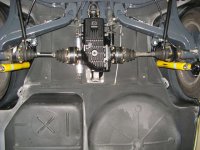I have had a "clunk" in my rear axle area since I got the car completed and as I checked for sources I found what feels like some play in one of the CV joints/axle splined attachment points. I have read here that the CV joints for our cars are NLA and in fact the complete axles appear to be NLA.
However, when I searched Worldpac speedial I came up with part number 33211205840 which appears to be a Porsche part that Worldpac feels will work. A reverse search of the 840 CV joint number shows it to be the E3 part. I have read here that the E3 CV joint won't work on our cars. Has anyone tried the Worldpac part on an E9? If you search the 840 part number on Pelican, it shows the same cross reference to a Porsche part number which makes sense because I think Pelican uses Worldpac to source OEM replacement parts.
If those parts won't work I will source a good used one from LJI or Coupeking. Any help is appreciated.
However, when I searched Worldpac speedial I came up with part number 33211205840 which appears to be a Porsche part that Worldpac feels will work. A reverse search of the 840 CV joint number shows it to be the E3 part. I have read here that the E3 CV joint won't work on our cars. Has anyone tried the Worldpac part on an E9? If you search the 840 part number on Pelican, it shows the same cross reference to a Porsche part number which makes sense because I think Pelican uses Worldpac to source OEM replacement parts.
If those parts won't work I will source a good used one from LJI or Coupeking. Any help is appreciated.
Attachments
Last edited:

